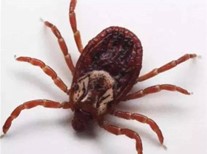Little bugs, big worries.
Summer arrived, all kinds of mosquitoes began to gradually become active. Did you know that there is such a small insect that can quietly adhere to the skin of people and suck blood, which is harmful to human health?
1.What is a tick?
Ticks: Also known as "grass crawlies", are a blood-sucking arthropod second only to mosquitoes. Their bites can occur all year round, but the peak risk is from April to September each year. Ticks are commonly found in forest pastures, grass, plants or fur of livestock, and are typical vectors and reservoirs of zoonotic diseases.

2.How can I tell if I'm bitten by a tick?
First, the patients participated in activities with a risk of exposure to ticks, such as outdoor sports, camping, hiking, or working in forestry and agriculture.
Ticks tend to live in areas where the skin is thinner and less visible. Tick bites release anesthetics, so the human body often can't feel them. When not sucking blood, the abdomen and back are flat, the back is slightly raised, the adult body length is 2 ~ 10mm, and the small shriveled as the size of mung bean; After absorbing full blood, there is a full size of soybeans, the largest can be up to 30mm. 1-2 days after being bitten, the mild manifestations are local erythema on the bite site, and there is a petechial or ecchymosis in the center of the bite. In severe cases, erythema around petechiae may appear edema or papules, blisters, and may be accompanied by chills, fever, headache, abdominal pain, nausea, vomiting and other "tick bite fever" symptoms. Nodules may appear later, and ulcers may be formed after scratching.
3.What if I get bitten by a tick?
Scientific and calm treatment of tick bites is key.
① Do not forcibly pull out the worm body with your hand, so as not to be torn by its serrated mouth parts or break the mouth parts in the skin, let alone crush the worm body with your hand; Use tweezers to hold the tick as close to the skin as possible, as close to its mouth as possible, and then pull the tick straight out of the skin without spinning or agitating.
② You can use chloroform, ether, turpentine and other drops on the head of the tick, and after a period of time the tick will release its mouth and come out It can be thickly coated with petroleum jelly, liquid paraffin, glycerin, mupirocin ointment, etc., to isolate the air around the tick, so that it suffocates to death, and then gently remove the tick with tweezers.
③ After removing the tick, clean the wound and hands with alcohol or soapy water, and check the insect body and bite site. If the mouth parts are broken in the skin, they need to be removed by surgery;
If you feel that the tick has been attached for more than 24 hours, the tick has not been completely removed, or you develop symptoms such as rash, fever, fatigue, headache, muscle pain, and joint swelling within 30 days after the tick bite, please seek medical attention.
4.How can I prevent tick bites?
① Avoid staying in the tick habitat, away from grass, bushes, etc.;
(2) If you go to the outskirts of the grassland, forest and other areas, it is best to wear light-colored pants and long sleeves, in order to find the tick attached in time, and plug the pant legs into the mouth of the socks, wear hats, masks, etc., to minimize the exposed parts;
③ Use an insect repellent spray containing DEET on exposed skin. It should be noted that newborns under 2 months of age should not use mosquito repellents and can be physically covered by mosquito nets;
(4) After returning from the rural grassland, forest and other areas, pay attention to check the clothes and various parts of the body, especially the neck, behind the ears, armpits, inner thighs, pubic area and groin, etc., to ensure that there are no ticks attached;
Contributed by: Dr. Liu Wei, The First Hospital of Jilin University
Reviewer: Li Shanshan, Chief physician, The First Hospital of Jilin University
(The views expressed are those of the author)

